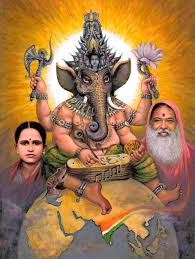We have so far completed the Bala Kanda of the Shata Shloki Ramayana. In this, Narada Maharishi while explaining the traits of Rama, has subtly explained the birth and the story of Rama. We shall now seek to understand those subtle details.
One day, Valmiki who had heard the complete story of Ramayana from Narada Maharishi, went to the River Tāmasa. There he saw a couple of birds engaged in playful sports. All of a sudden, a hunter mercilessly killed the male bird. Distraught, Valmiki Maharishi instantaneously cursed the hunter. Much to the saints astonishment, the curse which came from his mouth was in the form of a hymn.
Exactly at that minute Lord Brahma appeared before him and said, “O great sage! It was I who got that hymn uttered by you. Please compose the entire story of Ramayana in hymns of this similar pattern. You will come to understand thoroughly the secretive and hidden messages within them. There will be no error of any kind in your composition. Your composition will remain on earth for as long as mountains and rivers exist on earth. In earth and in other planetary systems, as long as your composition of Ramayana exists, you will live”. Saying so, Brahma disappeared.
Abiding by the orders of Lord Brahma, Valmiki began to compose Ramayana. As he sat with his palms joined and focused his attention, the entire story flashed before his mind in minute detail. He could see King Dasharatha, his conversation with his queens, Rama and Sita, their exile, and their movements completely. What more can be said of his fortune!
It was during the period of Rama’s rule, that Valmiki Maharishi composed the Ramayana. The future story was composed under the heading ‘Uttara Kanda’. He even taught this entire story to the twins Kusha-Lava, who were growing up there. He made them render the entire composition in the form of a song.
With the permission of their Guru Valmiki, these twins began singing and spreading the story of Rama in all directions. Rama, who came to know of this fact, invited the twins to the palace and together with his brothers, sat to listen to their rendition. Mesmerized by their song, Rama got up from his throne, came down and sat on the floor amidst all the citizens and began to listen attentively to it.
This is how the story of Ramayana was born.
Among the greatest rulers of the earth were the kings who belonged to the Ikshvaku dynasty. They ruled the kingdom of Kosala with Ayodhya as their capital. This city was built by Manu and developed by Dasharatha. Dasharatha was childless for a very long time. When he was about to begin the Ashwamedha yaaga, his minister Sumantra spoke to him about Sage Rishyashringa and his greatness. Dasharatha invited the great sage to his palace and also conducted the Putra Kameshti yaaga (ritual conducted for begetting children) under the able guidance of the sage. The Gods were pleased and from the homa fire, Dasharatha received a bowl of payasam (a type of Indian milk pudding) with instructions that it should be consumed by the queens.
Exactly at this time, the Gods had assembled in front of Vishnu and prayed to Him, “O Lord, the atrocities of Demon Ravana are beyond tolerance. This demon has procured the most difficult boons which have made it impossible to slay him. He who considers humans as insignificant, has sought a boon that his end should be at the hands of a human being. So we request you to kindly incarnate as the son of Emperor Dasharatha”.
When Srihari obliged, the Devatas who were thrilled immediately incarnated as Vanaras. On an auspicious day, the three queens of Dasharatha gave birth to 4 sons. Vashistha Maharishi named the eldest amongst them, the son of Kaushalya, as Srirama. The son of Kaikeyi was named Bharata. Sumitra had twins- the eldest amongst them was named Lakshmana and the youngest was Shatrughna. This is the story of Ramayana contained in the Bala Kanda.
Om Seeta raamabhyaam namaha.
